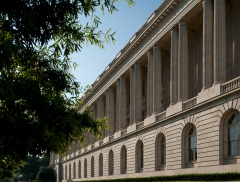
Featured
The Frieze of American History in the Rotunda of the United States Capitol...
Featured
Featured
Find out how the AOC's painters use tricks of the trade to turn wood into...


Frequently Asked Questions about the Cannon Renewal Project, which is currently in, its early planning stages.
The Cannon House Office Building is the oldest office building on the Capitol campus, dating back to 1908. Due to its advanced age, the House of Representatives is in the early planning stages for a top-to-bottom renewal of the Cannon House Office Building.
What is the purpose of the project?
We have reached a critical stage in the life of the Cannon Building. The century-old building is plagued with serious safety, health, environmental, and operational issues that are rapidly worsening. Without action, the essential systems housed behind the walls and in mechanical rooms will continue to crumble and fail, impacting Members, staff and constituents. To address these urgent problems and to ensure the Cannon Building provides an effective congressional workplace into the next century, the Architect of the Capitol (AOC) has begun planning for the complete renewal of the building.
What is the status of the project?
The AOC has assembled a team of in-house experts and consultants who are working with House leaders to define key aspects of the project. This initial effort will better define the estimated costs, scope of work, and potential timeline for the work. We expect this initial planning to conclude in 2012. The next step will be to initiate the detailed design process, which is expected to take approximately two years. The current step is the schematic design process, which is expected to take approximately two years.
How can we ensure the project delivers good value to the taxpayer?
The AOC is committed to maximizing taxpayer value, reducing the risk of cost overruns and delays, and minimizing disruption to the work of Congress. During the initial steps of the project, AOC is working closely with the House to clearly define requirements now to avoid future changes that may cause cost increases and delays. Additionally, AOC is partnering with the Government Accountability Office (GAO) and Government Services Administration (GSA) to incorporate lessons learned from other similar, complex projects and to implement risk mitigation strategies.
What are the benefits of the project?
Fundamentally, the project will improve the quality and ensure the reliability of key building systems such as heating, cooling, lighting, plumbing, fire and life safety, accessibility, and structural integrity. Equally important, the project will improve the functionality of the building for both Members and staff, making it far more efficient, comfortable, and safer. Similar projects have been completed, and are ongoing, throughout the executive branch including the Eisenhower Executive Office Building and the headquarters of the Departments of Interior, Justice, Treasury and Commerce.
When will this impact Members of Congress?
For the next several years, during the planning and design stages, there will be little impact to Members or congressional operations. The AOC will continue working closely with House leadership to define a phasing strategy for the construction work. Members and other building occupants will be informed well in advance of any actions that will impact office assignments.
The current plan envisions keeping the buildings open during the work, with sequential renovation of all floors on one side of the building at a time, while the other sections remain occupied. Work on the Cannon House Office Building will not commence until 2015, and phased relocation is not scheduled to occur until 2016/2017, coordinated with the Congressional Transition.
Additional member suites will be built out in Rayburn and Longworth and included in the existing election cycle lottery process. Offices in a section of Cannon closed for renovation will be excluded from the lottery process during each construction phase. Temporary member suites will be created by relocating certain House support offices and committee staff to the Ford Building and/or leased space in the newly renovated Federal Office Building 8, located next to the Ford Building. Final space use decisions will be made by House leadership.